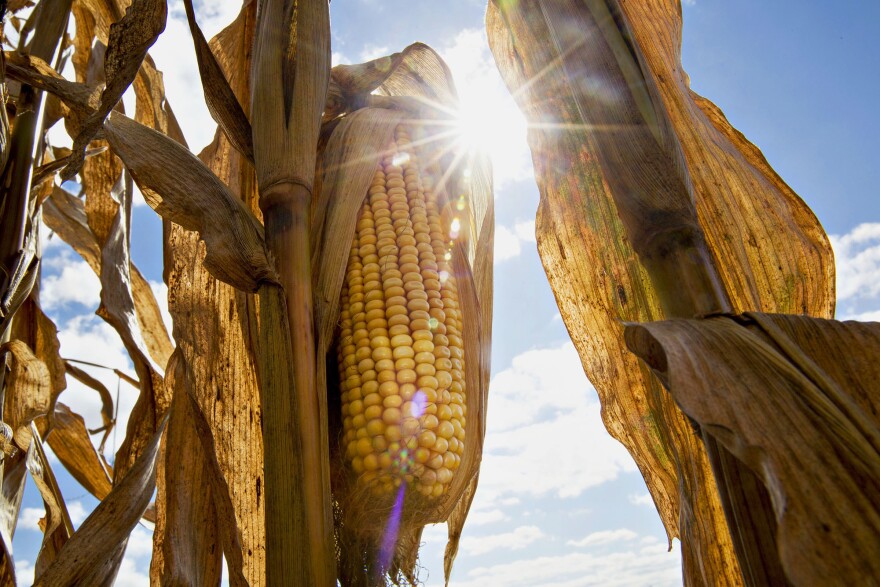On Aug. 21, a 70-mile-wide ribbon from Oregon to South Carolina called the "path of totality" will experience a total solar eclipse. Large swaths of farmland in the Great Plains and Midwest will be plunged into darkness for 2 1/2 minutes, and temperatures will drop about 10 degrees in the middle of the day.
But as millions of people look up at the sky, many Midwest scientists will turn their eyes and cameras toward the plants and animals on the ground. And they're not sure what will happen.
"It's never really been studied systematically," says Angela Speck, director of astronomy at the University of Missouri, Columbia.
Speck says different parts of the Earth experience a total eclipse about once a year, and that makes tracking changes in animal and plant behavior challenging.
"The place that gets to see that total eclipse is only about 0.1 percent of the surface of the Earth," she says. "So even though they happen every year in a given location, they are very rare."
Researchers at the University of Missouri are using the South Farm Research Center, which falls right in the path of totality, to document corn, soybeans and livestock through live-stream webcams.

Tim Reinbott, director of field operations, says he is eager to see how those drought-stressed plants will react to the change in light and temperature. Typically, they cope by twisting up their leaves during the day to prevent loss of moisture. At night, they unfold to breathe in carbon dioxide.
"During the middle of all of this, will it unfold itself and then fold itself right back up in response to the eclipse?" Reinbott asks. "I don't know. Maybe it's too quick. Whether they work or not, we're going to learn something."
Indeed, a lot of research is done in labs to see how plants, including those stressed by drought, react to different conditions. But Reinbott says the eclipse is so unique that it would be a challenge to mimic those exact conditions in a greenhouse or a pasture.
"Also we've got the full spectrum of the sun — all the shades of red lights, green lights and blues. It's hard to get that artificially," he says.
For farmers, the rows of corn and soybeans striping through the Midwest will only briefly dip into photosynthesis — the process by which plants convert light into energy. University of Missouri plant biologist Mannie Liscum says any light or temperature changes that hit the crops during the eclipse will come out as a wash during harvest — no bushels lost.
"The reason for that is that plants normally are adapting to local environments because they are fixed in the soil," he says. "They can't escape their environment, so they undergo huge changes in their light environment during the course of a single day."
Animals, however, are not fixed in the soil. At the South Farm Research Center, Reinbott will have the cameras pointed at horses, which he anticipates might act frisky because they'll think it's dinner time.
He'll also have cameras streaming the behavior of chickens in a coop.
"I think they'll be real reactive to [the eclipse]," he says. "They may say, 'You know, maybe I need to stay out here and eat some more?' I don't know."
With the help of elementary school students, University of Missouri biology professor Candi Galen is putting out microphones near beehives, in gardens and in a pumpkin patch to record buzzing activity.
"I don't think it is really known the cues that bees use or don't use when they are foraging that tell them to jump ship and go back their hives or stay put," Galen says. "Bees depend upon the environment to regulate their temperature, and that may suggest that if indeed it does cool off a few degrees as the eclipse progresses, then they would get less active because they would be at a lower temperature physiologically."
Researchers are also working with nearby cattle ranchers and even fishermen to monitor fish activity, Reinbott says.
"What they observe, let us know, and you get enough folks observing the same thing, that's a replicated trial," he says.
Ultimately, Reinbott says, we might not learn a groundbreaking fact during these eclipse studies that can be applied immediately to science. But maybe something will be learned that researchers can use down the line to improve food production.
"What we learn here, we may not even be able to fathom what could be used years from now," he says.
This story comes to us from Harvest Public Media, a reporting collaboration that focuses on agriculture and food production. Kristofor Husted is based at member station KBIA in Columbia, Mo.
Copyright 2017 KBIA


